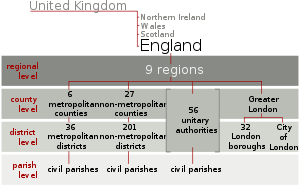Anglo-Saxon local government (700–1066 AD)[edit]
The Kingdom of Wessex, c. 790 AD, was divided into administrative units known as shires. Each shire was governed by an Ealdorman, a major nobleman of Wessex appointed to the post by the King. The term 'Ealdorman' (meaning 'elder-man') gradually merged with the Scandinavian Eorl/Jarl (designating an important chieftain), to form the modern 'Earl'. However, the Shires were not comparable with later Earldoms, and were not held in the Ealdorman's own right.
The shires of Wessex at this time have essentially survived to the present day, as counties of England (currently ceremonial counties). They included Defnascir (Devon), Sumorsaete (Somerset), Dornsaete (Dorset), Wiltunscir (Wiltshire), Hamptunscir (Hampshire). When Wessex conquered the petty kingdoms of southern England, namely Cent and that of the South Saxons, these were simply reconstituted as shires (modern Kent and Sussex respectively).
As Wessex took over progressively larger areas of Mercia, East Anglia and Northumbria, the new lands were divided into shires, usually named after the principal town in the new shire; hence Northamptonshire, Oxfordshire, Derbyshire and so on. Most of the historic counties of England (and modern Ceremonial counties) south of the Mersey and Humber derive directly from this time.
Another important official of the shire was the shire-reeve, from whence the more modern sheriff is derived. The shire-reeve was responsible for upholding the law, and holding civil and criminal courts in the shire.[1] The office of sheriff is still important in some Anglophone countries (e.g. the USA), but now a ceremonial role in the England

No comments:
Post a Comment